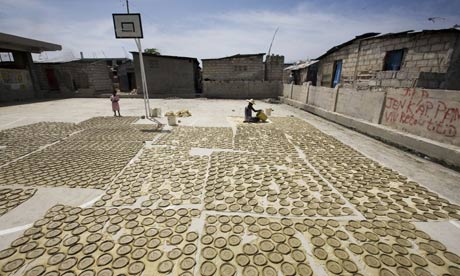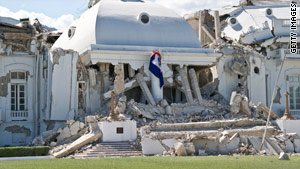Haiti devastation exposes shoddy construction
 Even buildings in downtown Port-au-Prince came tumbling down
Even buildings in downtown Port-au-Prince came tumbling down
By Ayesha Bhatty
BBC News, London

Experts say it is no surprise that shoddy construction contributed to the level of destruction in Haiti following Tuesday's earthquake. But the scale of the disaster has shed new light on the problem in the impoverished Caribbean nation.
Tens of thousands are feared dead after being crushed by buildings that collapsed. Scores more remain trapped under the rubble.
"It's sub-standard construction," says London-based architect John McAslan, who has been working on a project linked to the Clinton Global Initiative in the country.
"There aren't any building codes as we would recognise them," he added.
Mr McAslan says most buildings are made of masonry - bricks or construction blocks - which tend to perform badly in an earthquake.
Cheap concrete

 Concrete blocks are being made in people's backyards and dried out in the sun
Concrete blocks are being made in people's backyards and dried out in the sun 
Peter Haas
Appropriate Infrastructure Development Group
There are also significant problems with the quality of building materials used, says Peter Haas, head of the Appropriate Infrastructure Development Group, a US-based non-profit group that has been working in Haiti since 2006.
"People are skimping on cement to try to cut costs, putting a lot of water in, building too thin, and you end up with a structure that's innately weaker," said Mr Haas, who was on his way to Haiti to help assess the safety of damaged buildings.
"Concrete blocks are being made in people's backyards and dried out in the sun," he said.
Mr Haas said there were also "serious problems" with the enforcement of building codes in Haiti.
He said the government did not function at all in several parts of the country, and many communities lacked basic services such as electricity, sanitation services or access to clean water.
"So the problem of code enforcement is low down on the list," he said.
Poor record
Even before the quake, Haiti's building safety record was poor.
Almost 100 people - mostly children - died when two schools collapsed within days of each other in November 2008. At the time, Haitian authorities blamed poor construction for the accidents.
Roger Musson, head of seismic hazard at the British Geological Survey, said he was "not at all" surprised at the level of destruction in Haiti.
 Some homes on hillsides collapsed on to the ones below [Photo: American Red Cross]
Some homes on hillsides collapsed on to the ones below [Photo: American Red Cross]
He said Haiti, the poorest country in the western hemisphere, was not used to dealing with earthquakes of this magnitude.
Tuesday's quake was the worst in two centuries. The country is more used to dealing with hurricanes, which have been getting more frequent in recent years, according to Mr Musson.
"Most buildings are like a house of cards," he said. "They can stand up to the forces of gravity, but if you have a sideways movement, it all comes tumbling down."
Ironically, people living in the shanty towns might have had a better chance of survival than those trapped under concrete buildings, many of which "pancaked".
"A simple shack's collapse is likely to cause less damage to human safety than a multi-floor building that collapses," Mr McAslan said.
Aftershocks
Mr McAslan says it is more complex and expensive to earthquake-proof a building than equip it for hurricane damage.
"The priorities have inevitably been elsewhere, but I'm absolutely certain that the attention of the government will be to build back better."
He said the main task for the authorities now was to save as many lives as possible, then to stabilise damaged buildings so they could withstand any aftershocks, and finally, to assess how to create buildings that could reasonably withstand another earthquake.
According to Mr McAslan, the extent of deforestation in Haiti also contributed to devastation.
He said that on the hillsides of Petionville, a suburb east of Port-au-Prince, buildings simply "collapsed and collapsed and collapsed" on to each other as there was no forest to protect them.
According to the US Geological Survey, the loss of life from earthquakes is typically 10 times higher in developing countries than the West and the damage can be up to 100 times worse.
 Even buildings in downtown Port-au-Prince came tumbling down
Even buildings in downtown Port-au-Prince came tumbling downBy Ayesha Bhatty
BBC News, London

Experts say it is no surprise that shoddy construction contributed to the level of destruction in Haiti following Tuesday's earthquake. But the scale of the disaster has shed new light on the problem in the impoverished Caribbean nation.
Tens of thousands are feared dead after being crushed by buildings that collapsed. Scores more remain trapped under the rubble.
"It's sub-standard construction," says London-based architect John McAslan, who has been working on a project linked to the Clinton Global Initiative in the country.
"There aren't any building codes as we would recognise them," he added.
Mr McAslan says most buildings are made of masonry - bricks or construction blocks - which tend to perform badly in an earthquake.
Cheap concrete

 Concrete blocks are being made in people's backyards and dried out in the sun
Concrete blocks are being made in people's backyards and dried out in the sun 
Peter Haas
Appropriate Infrastructure Development Group
There are also significant problems with the quality of building materials used, says Peter Haas, head of the Appropriate Infrastructure Development Group, a US-based non-profit group that has been working in Haiti since 2006.
"People are skimping on cement to try to cut costs, putting a lot of water in, building too thin, and you end up with a structure that's innately weaker," said Mr Haas, who was on his way to Haiti to help assess the safety of damaged buildings.
"Concrete blocks are being made in people's backyards and dried out in the sun," he said.
Mr Haas said there were also "serious problems" with the enforcement of building codes in Haiti.
He said the government did not function at all in several parts of the country, and many communities lacked basic services such as electricity, sanitation services or access to clean water.
"So the problem of code enforcement is low down on the list," he said.
Poor record
Even before the quake, Haiti's building safety record was poor.
Almost 100 people - mostly children - died when two schools collapsed within days of each other in November 2008. At the time, Haitian authorities blamed poor construction for the accidents.
Roger Musson, head of seismic hazard at the British Geological Survey, said he was "not at all" surprised at the level of destruction in Haiti.
 Some homes on hillsides collapsed on to the ones below [Photo: American Red Cross]
Some homes on hillsides collapsed on to the ones below [Photo: American Red Cross]He said Haiti, the poorest country in the western hemisphere, was not used to dealing with earthquakes of this magnitude.
Tuesday's quake was the worst in two centuries. The country is more used to dealing with hurricanes, which have been getting more frequent in recent years, according to Mr Musson.
"Most buildings are like a house of cards," he said. "They can stand up to the forces of gravity, but if you have a sideways movement, it all comes tumbling down."
Ironically, people living in the shanty towns might have had a better chance of survival than those trapped under concrete buildings, many of which "pancaked".
"A simple shack's collapse is likely to cause less damage to human safety than a multi-floor building that collapses," Mr McAslan said.
Aftershocks
Mr McAslan says it is more complex and expensive to earthquake-proof a building than equip it for hurricane damage.
"The priorities have inevitably been elsewhere, but I'm absolutely certain that the attention of the government will be to build back better."
He said the main task for the authorities now was to save as many lives as possible, then to stabilise damaged buildings so they could withstand any aftershocks, and finally, to assess how to create buildings that could reasonably withstand another earthquake.
According to Mr McAslan, the extent of deforestation in Haiti also contributed to devastation.
He said that on the hillsides of Petionville, a suburb east of Port-au-Prince, buildings simply "collapsed and collapsed and collapsed" on to each other as there was no forest to protect them.
According to the US Geological Survey, the loss of life from earthquakes is typically 10 times higher in developing countries than the West and the damage can be up to 100 times worse.
 In Cité Soleil, one of Port-au-Prince's worst slums, making the clay-based food is a major income earner. Mud cakes are the only inflation-proof food available to Haiti's poor.
In Cité Soleil, one of Port-au-Prince's worst slums, making the clay-based food is a major income earner. Mud cakes are the only inflation-proof food available to Haiti's poor.




Comment